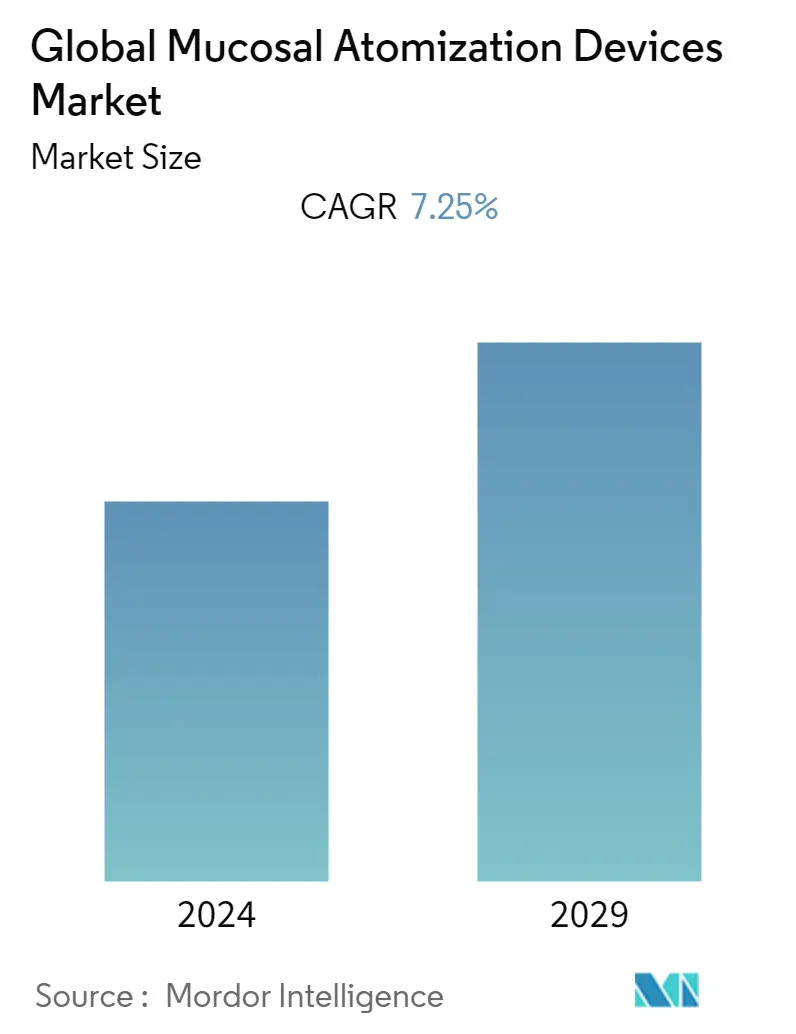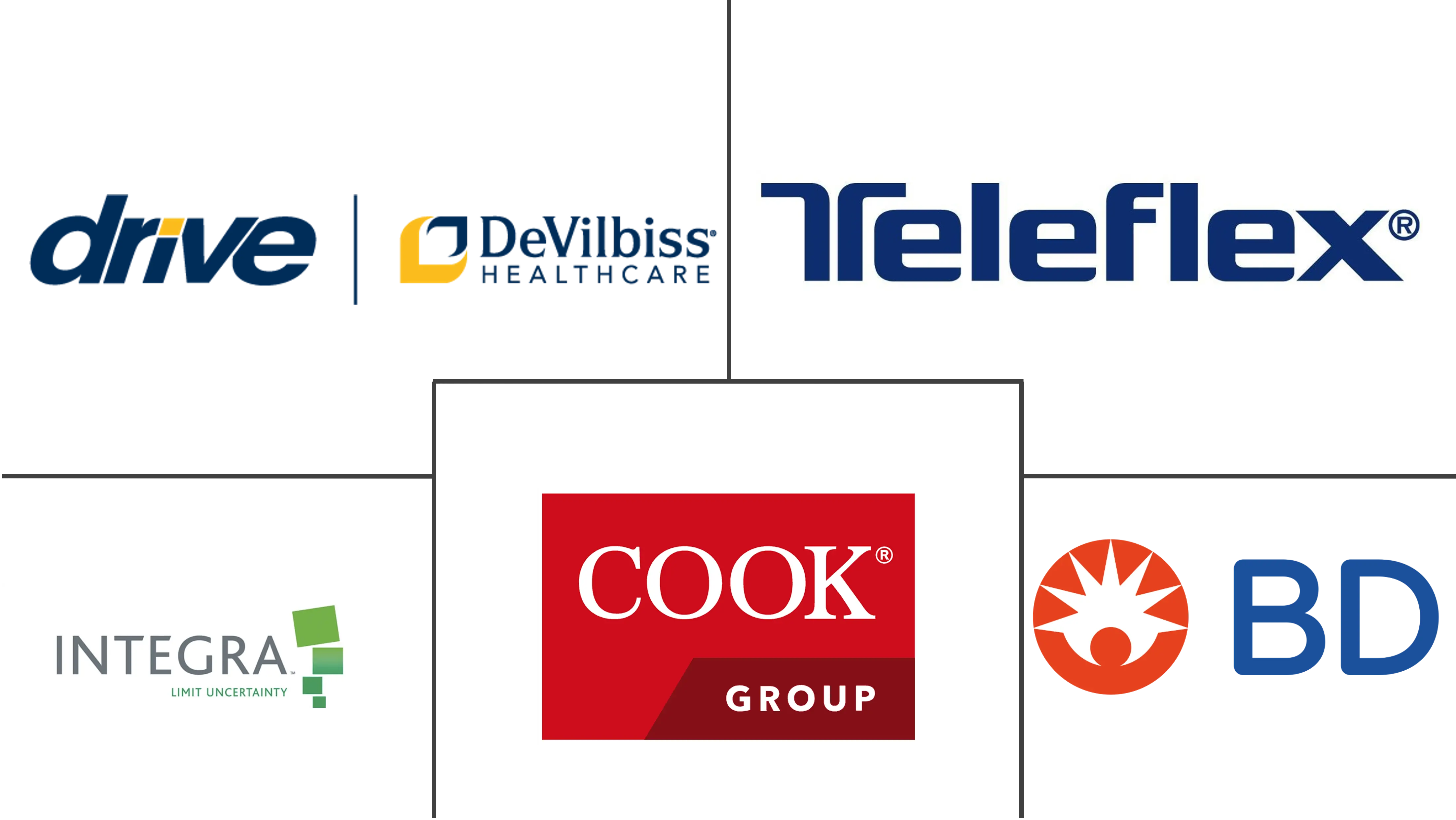Market Size of Global Mucosal Atomization Devices Industry

| Study Period | 2019 - 2029 |
| Base Year For Estimation | 2023 |
| Forecast Data Period | 2024 - 2029 |
| CAGR | 7.25 % |
| Fastest Growing Market | Asia-Pacific |
| Largest Market | North America |
Major Players
*Disclaimer: Major Players sorted in no particular order |
Mucosal Atomization Devices Market Analysis
The mucosal atomization devices market is projected to record a CAGR of nearly 7.25% over the forecast period.
During the initial phase, the COVID-19 pandemic adversely affected communities, industries, and markets, including mucosal atomization devices. For instance, as per a survey conducted by the International Archives of Allergy and Immunology in January 2021, only 13% of physicians continued skin prick testing with commercial inhalant extracts, while 31% of physicians performed skin pricking tests in rare cases. However, all the respondents were observed to be continuing their asthma and allergic rhinitis medication, including inhaled corticosteroids, long-acting β2-agonists, Montelukast sodium, antihistamines, and nasal steroids. Over 92% of physicians reported prescribing inhaled medication to COVID-19 patients for instances of emergency management. In the current scenario, as the restrictions eased, the market is anticipated to witness growth because of the increase in the adoption of mucosal atomization devices due to the advantages offered by the devices in drug delivery. For instance, as per the article published in February 2022 in eBioMedicine journal, immune responses at the mucosal and systemic levels may be induced via mucosal immunization. Nine vaccines against different mucosal infections have been licensed for human use, including eight provided orally and one given intranasally (IN), all of which are complete viral vaccines.
The major factor contributing to the market growth is the increase in the prevalence of allergic rhinitis, sinus, and other target diseases across the world. For instance, as per the Allergy Capital Report 2022, one of the most common allergic conditions is seasonal allergic rhinitis, often called 'hay fever.' About 7.7% of adults and 7.2% of children have been diagnosed with seasonal allergic rhinitis in the United States. Similarly, as per the June 2022 update from European Parliament, allergies are among the most common chronic noncommunicable diseases in Europe. In 2022, about 150 million people in Europe live with an allergic condition, such as allergic rhinitis, asthma, atopic eczema, or a food allergy. Hence, the rise in allergy diseases across the globe is anticipated to increase the demand for mucosal atomization devices, thereby driving market growth.
Mucosal atomization devices help in faster delivery of medication in the bloodstream, thus reducing the time for therapeutics to act on the concerned medical issue. As these drugs directly enter the bloodstream, they avoid first-pass metabolism and offer quicker results. Further, the increasing number of epilepsy cases among the population is increasing the adoption of mucosal atomization devices to quickly administer the drug intranasally in emergencies. For instance, according to an article published in Taylor and Francis, in March 2021, it had been observed that midazolam mucosal nasal spray rapidly absorbs, in adult and pediatric patients with seizures/epilepsy, and helps in terminating the seizure activity. This shows the viable tolerability of midazolam nasal spray through mucosal atomization devices in the patients which is expected to increase the demand for midazolam nasal spray for treating patients with epilepsy, thereby propelling the market growth.
Moreover, technological advancements and developments in mucosal atomization devices are expected to boost market growth since they increase convenience and thereby lead to the adoption of the devices. For instance, in October 2021, Alcove Manufacturing and Distribution Inc. and Pulmodyne Inc. collaborated to expand distribution, consolidate manufacturing, and continue cooperative research of novel atomization technologies. With this new partnership, Pulmodyne distributed the EZ-Spray Atomization System through its existing channels. In addition to distribution, the partnership seeks to innovate further in the space, and this relationship will allow the two experienced companies to optimize product designs quickly.
In the midst of these developments, side effects due to the overdose of drugs are expected to restrain the market growth.
Mucosal Atomization Devices Industry Segmentation
As per the scope of the report, mucosal atomization devices are specific types of devices used to administer drugs through the tracheal mucosal, oral, and nasal surfaces. They are systematic and enable needle-free drug delivery. They are largely used during emergency and pre-hospital treatments.
The Mucosal Atomization Devices Market is Segmented by Product Type (Gas-propelled and Electrical), End User (Hospital, Clinics, and Other End Users), and Geography (North America, Europe, Asia-Pacific, and the Rest of the World). The report offers the value (in USD million) for the above segments.
| By Product Type | |
| Gas-propelled | |
| Electrical |
| By End User | |
| Hospitals | |
| Clinics | |
| Other End Users |
| Geography | ||||||||
| ||||||||
| ||||||||
| ||||||||
| Rest of the World |
Global Mucosal Atomization Devices Market Size Summary
The mucosal atomization devices market is poised for significant growth, driven by the increasing prevalence of allergic conditions and the rising demand for efficient drug delivery systems. These devices offer rapid medication delivery directly into the bloodstream, bypassing first-pass metabolism and ensuring quicker therapeutic effects. The market's expansion is further supported by technological advancements and collaborations among key industry players, which enhance product convenience and efficacy. The easing of COVID-19 restrictions has also contributed to the market's recovery and growth, as the devices prove beneficial in managing respiratory conditions and administering vaccines. However, potential side effects from drug overdoses may pose challenges to market growth.
North America is expected to maintain a substantial share of the global market, supported by a robust healthcare infrastructure and a high incidence of allergic diseases. The region's market is bolstered by the presence of major players and ongoing technological innovations in mucosal atomization devices. The rise in air pollution-related allergies, particularly in urban areas, further fuels the demand for these devices. The market is moderately competitive, with key companies like Teleflex Incorporated and DeVilbiss Healthcare LLC leading the charge. Strategic acquisitions and partnerships, such as Intersurgical's acquisition of Pulmodyne, are expected to enhance market presence and drive sales growth.
Global Mucosal Atomization Devices Market Size - Table of Contents
-
1. MARKET DYNAMICS
-
1.1 Market Overview
-
1.2 Market Drivers
-
1.2.1 Increasing Prevalence of Allergic Rhinitis, Sinus, and Other Target Diseases
-
1.2.2 Technological Advancement in Mucosal Atomization Devices
-
-
1.3 Market Restraints
-
1.3.1 Side Effects Due to Overdose
-
-
1.4 Porter's Five Forces Analysis
-
1.4.1 Threat of New Entrants
-
1.4.2 Bargaining Power of Buyers/Consumers
-
1.4.3 Bargaining Power of Suppliers
-
1.4.4 Threat of Substitute Products
-
1.4.5 Intensity of Competitive Rivalry
-
-
-
2. MARKET SEGMENTATION (Market Size by Value- USD Million)
-
2.1 By Product Type
-
2.1.1 Gas-propelled
-
2.1.2 Electrical
-
-
2.2 By End User
-
2.2.1 Hospitals
-
2.2.2 Clinics
-
2.2.3 Other End Users
-
-
2.3 Geography
-
2.3.1 North America
-
2.3.1.1 United States
-
2.3.1.2 Canada
-
2.3.1.3 Mexico
-
-
2.3.2 Europe
-
2.3.2.1 Germany
-
2.3.2.2 United Kingdom
-
2.3.2.3 France
-
2.3.2.4 Italy
-
2.3.2.5 Spain
-
2.3.2.6 Rest of Europe
-
-
2.3.3 Asia-Pacific
-
2.3.3.1 China
-
2.3.3.2 Japan
-
2.3.3.3 India
-
2.3.3.4 Australia
-
2.3.3.5 South Korea
-
2.3.3.6 Rest of Asia-Pacific
-
-
2.3.4 Rest of the World
-
-
Global Mucosal Atomization Devices Market Size FAQs
What is the current Global Mucosal Atomization Devices Market size?
The Global Mucosal Atomization Devices Market is projected to register a CAGR of 7.25% during the forecast period (2024-2029)
Who are the key players in Global Mucosal Atomization Devices Market?
Teleflex Incorporated, DeVilbiss Healthcare LLC, Becton, Dickinson and Company, Cook Medical and Integra LifeSciences are the major companies operating in the Global Mucosal Atomization Devices Market.

